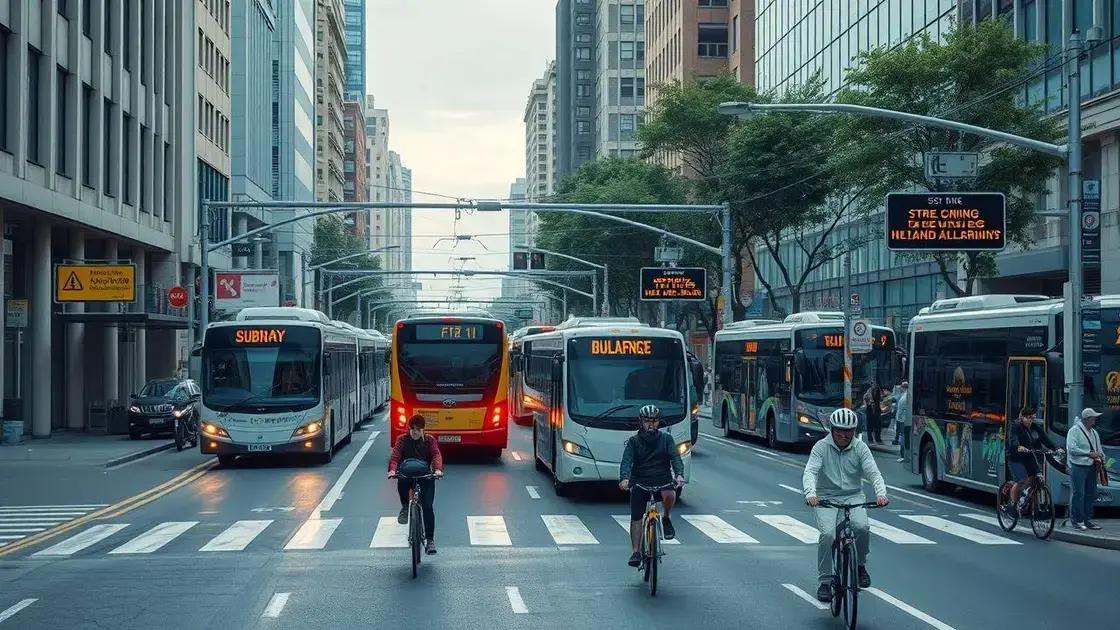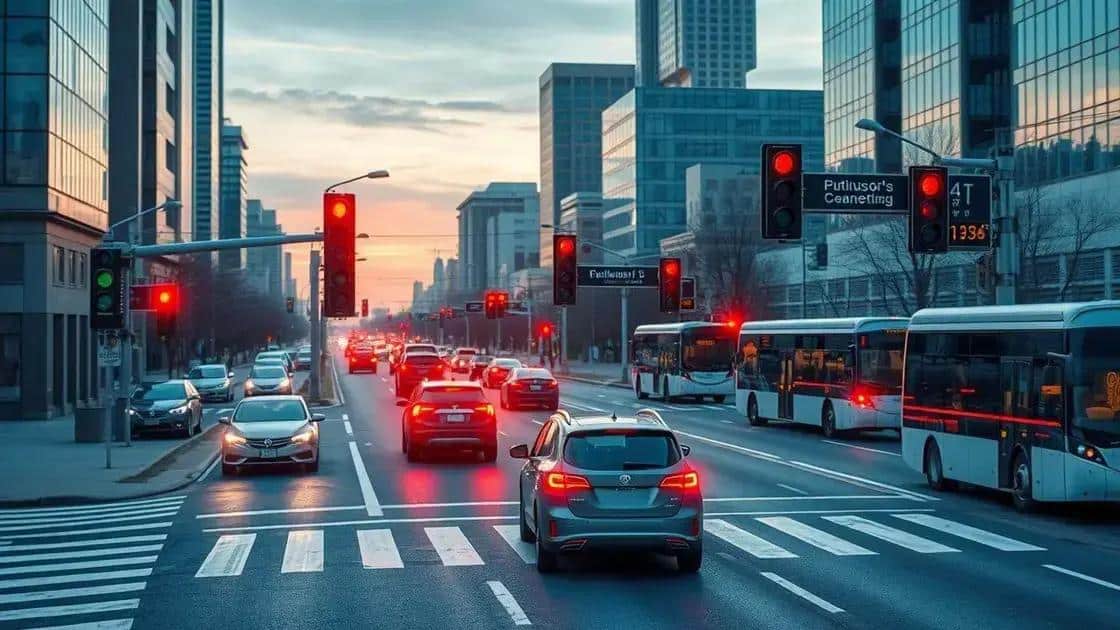Rich transport infrastructure news that you need to know

Rich transport infrastructure news highlights advancements in technology and sustainability, emphasizing the development of smart systems, electric vehicles, and community involvement in planning for future mobility solutions.
Rich transport infrastructure news is making waves, influencing everything from daily commutes to international trade. Have you ever wondered how these developments might change your everyday life? Let’s dive in!
Understanding rich transport infrastructure
Understanding rich transport infrastructure is essential in today’s rapidly evolving world. This infrastructure plays a vital role in connecting people and goods, enhancing economic growth, and improving overall quality of life.
The various components of rich transport infrastructure include roads, railways, airports, and public transit systems. Together, these elements create a seamless network that facilitates movement across vast distances. Efficient transport systems not only reduce travel time but also lower transportation costs, making them beneficial for businesses and consumers alike.
Key Features of Rich Transport Infrastructure
Let’s explore some key features that define rich transport infrastructure:
- Integrated networks that connect multiple modes of transport.
- Innovative technologies, such as smart traffic management systems.
- Accessibility to underserved areas, promoting inclusivity.
- Seamless transfer points for passengers and freight.
Moreover, rich transport infrastructure contributes to environmental sustainability by encouraging the use of public transit and reducing dependency on personal vehicles. As infrastructure improves, cities can offer greener alternatives, such as electric buses or bike-sharing programs.
The benefits of comprehensive transport systems extend beyond mere convenience. They boost local economies by creating jobs, attracting investments, and stimulating trade. Regions with robust transport links often enjoy higher productivity and competitiveness, as businesses can access resources and markets more efficiently.
Impact on local economies
The impact on local economies from rich transport infrastructure is profound and multifaceted. Improved transportation networks enhance accessibility, allowing businesses and consumers to connect more efficiently.
When well-established transport systems are in place, they foster job creation by enabling new businesses to thrive and existing ones to expand. For instance, a new highway can significantly boost trade by facilitating the movement of goods. This not only benefits the companies involved but also uplifts the entire community.
Economic Growth Opportunities
Here are some ways that transport infrastructure impacts local economies:
- Increased accessibility leads to higher foot traffic and customer bases for local businesses.
- Job creation in construction and logistics sectors as projects develop.
- Attraction of new businesses due to improved connectivity.
- Enhanced property values in areas with better transport links.
Moreover, a strong transport infrastructure allows for better logistics management and reduces delivery times. This becomes a competitive advantage for local businesses—enabling them to serve customers more effectively.
Furthermore, the impact extends beyond direct economic benefits. Communities with rich transport infrastructure often see improvements in public services such as healthcare and education. When transportation is accessible, residents can travel to work, school, and medical facilities more easily. This enhanced mobility contributes to a healthier workforce and educated populace, which in turn fuels economic growth.
Benefits of advanced transport systems

The benefits of advanced transport systems greatly enhance the way we navigate our world. These systems not only improve efficiency but also revolutionize how people interact with their environments.
One significant advantage is the reduction of travel time. With more efficient routes and smarter traffic management, commuters can get to their destinations faster. This efficiency reflects not just in personal travel but also in freight and logistics, where timely deliveries can drastically improve service quality.
Key Advantages of Advanced Transport Systems
Here are some key benefits:
- Lower congestion levels on roads due to better traffic flow.
- Increased safety through smarter vehicle technology and infrastructure monitoring.
- Reduced environmental impact with the promotion of public transport and electric vehicles.
- Cost-effectiveness for both users and providers, resulting from efficiency gains.
Additionally, advanced transport systems encourage the use of sustainable practices. They’re designed with a focus on minimizing emissions, thus contributing to cleaner air and healthier communities. The integration of electric vehicles and renewable energy in transport systems significantly lessens our carbon footprint.
The adoption of advanced technologies also fosters innovation. For example, smart traffic signals can adjust based on real-time conditions. This adaptability not only improves user experience but also enhances overall urban planning.
Technology driving transport advancements
Technology is a key factor in driving transport advancements, shaping how we move around cities and across countries. Innovations in technology are constantly transforming the transportation landscape, making it more efficient, reliable, and safe.
One of the most significant technological advancements is the development of smart transportation systems. These systems use sensors and data analytics to improve traffic flow and manage transportation resources effectively. For instance, smart traffic lights can adjust in real-time to reduce congestion, enhancing the overall commuting experience.
Innovative Technologies in Transport
Here are some notable technologies that are making a difference:
- Autonomous vehicles: Self-driving cars are set to revolutionize how we think about personal and public transport.
- Electric vehicles (EVs): These vehicles are not only environmentally friendly but also promote energy efficiency.
- Connected vehicles: Cars that communicate with each other and with traffic infrastructure help to increase safety and reduce accidents.
- Mobility as a Service (MaaS): This concept integrates various transportation services into a single accessible platform.
The integration of mobile apps allows people to plan their journeys more effectively. Users can access real-time data on public transport schedules and traffic conditions, giving them the necessary information to make informed travel decisions. This level of convenience improves user satisfaction and encourages the use of public transport options.
Furthermore, technology enhances safety in transportation. Advanced driver-assistance systems (ADAS) make cars safer by providing features like emergency braking and lane-keeping assistance. These technological advances help to reduce the number of accidents on the roads, making travel safer for everyone.
Future trends in infrastructure development
The future trends in infrastructure development are shaping how we build and maintain our transport systems. As technology evolves, so do the strategies that cities and countries use to enhance their infrastructure.
One emerging trend is the focus on sustainability. Infrastructure projects increasingly emphasize eco-friendly materials and technologies. For instance, the use of recycled materials in construction is becoming more common. This not only limits waste but also reduces the carbon footprint associated with traditional building methods.
Key Trends to Watch
Here are some notable trends in infrastructure development:
- Smart infrastructure: Integration of sensors and IoT technologies allows real-time monitoring and management.
- Resilience planning: Infrastructure is being designed to withstand natural disasters and climate change impacts.
- Public-private partnerships: Collaborations between public entities and private companies enhance funding and innovation.
- Community involvement: Engaging local residents in planning processes ensures that development meets their needs.
Moreover, the rise of electric and autonomous vehicles is influencing infrastructure planning. Cities are beginning to reconfigure roadways and public transport systems to accommodate these new technologies. Charging stations for electric vehicles are being integrated into urban designs, ensuring accessibility and convenience for users.
Another important aspect is the shift toward multimodal transport. Future infrastructure will increasingly support seamless transitions among different modes of transportation, such as biking, walking, public transit, and driving. This integrated approach aims to reduce traffic congestion and improve overall mobility.
FAQ – Frequently Asked Questions about Transport Infrastructure Developments
What are the benefits of advanced transport systems?
Advanced transport systems help reduce travel time, lower congestion, and promote safety and sustainability in urban environments.
How does technology impact transportation planning?
Technology enhances transportation planning by integrating smart solutions, enabling real-time traffic management, and improving user experience through data collection.
Why is community involvement essential in infrastructure projects?
Community involvement ensures that infrastructure projects meet the needs of local residents and promotes public support and engagement in the development process.
What trends should we expect in future infrastructure development?
Future trends include a focus on sustainability, the rise of electric vehicles, smart transportation technology, and enhanced partnerships between public and private sectors.





